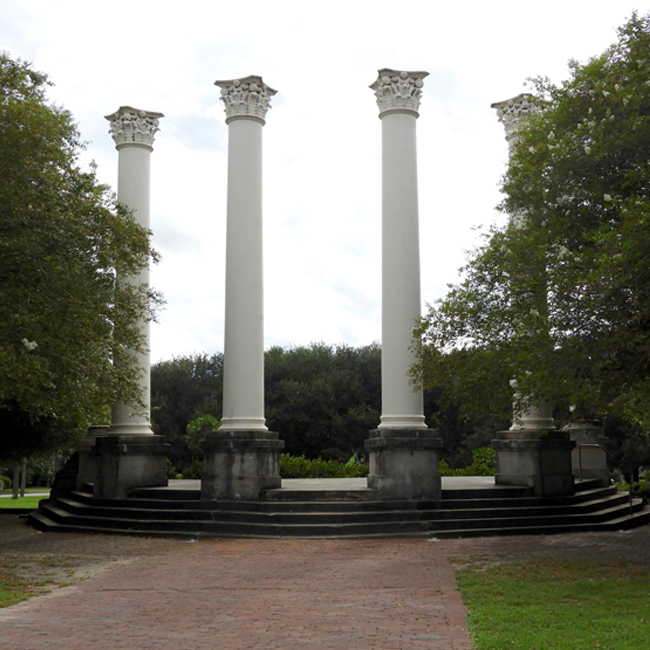
Cannon Park - 131 Rutledge Avenue
From my photograph you can see that there is no structure at Cannon Park; however, the site and remaining columns speak to a previous structure.
The property at 131 Rutledge Avenue was originally a pond, later filled in and donated in 1880 to the city as “Cannon’s Mall,” named after Daniel Cannon, an owner of saw mills near this area. Not long after the donation, Charleston hired Frederick Law Olmstead to draw up a landscape design for the property; Olmstead is a name associated with many of the city parks in the United States, notably Central Park in New York. He also laid out the grounds of the Biltmore Estate in North Carolina.
However, Olmstead’s landscape plan did not get put into place in Charleston until 1985 and then only partially; it is Cannon Park as we see it today. The ruins lend a stately character to the park where people bring their dogs and enjoy the peace and expanse of the property between Rutledge and Ashley Avenues.
Instead of executing the landscape plan from Olmstead, Charleston built a convention center, the Thomson Auditorium, on the property in 1899. In 1907 the Charleston Museum, circa 1773 and the oldest Museum in America, moved into the Auditorium, the final temporary space around town where the Museum’s collection was housed at. I have great memories of visiting the Museum as a child; I can still visualize walking in the entrance to see the giant whale skeleton hanging from the ceiling (the whale showed up in the Charleston Harbor in 1880).
Another favorite was the trunk of a Southern live oak tree cut to display the rings of age. The most unforgettable object in the Museum to me was the Egyptian mummy. It mesmerized and even terrified me and my friends (it still does). The taxidermied animals were a bit creepy but at least they were animals, not humans!
The Museum has always had an excellent collection of artifacts related to the city’s founding, including items prior to the arrival of the English settlers in 1670. The collection contains Native American artifacts and fossils, of which I was far more familiar with than fossilized Egyptians. Growing up on Edisto, I spent much of my time outdoors exploring the beach and the island. Finding Indian arrowheads was part of my childhood, as was hunting sharks’ teeth and other fossils. I remember a heavy, black, odd-shaped “something” that we used as a door stop; a friend of my parents saw it and suggested we send it to the Smithsonian which later identified it as part of the tooth of either a woolly mammoth or a mastodon. On its return to us, we continued to use it as a doorstop; we were simply living with history.
The old Charleston Museum mysteriously burned in 1981, leaving only the columns and my memories at 131 Rutledge. Fortunately, the entire collection escaped the fire, having previously been moved to the Museum’s new and permanent building at 360 Meeting Street.
Next week, we visit the “new” Charleston Museum.



